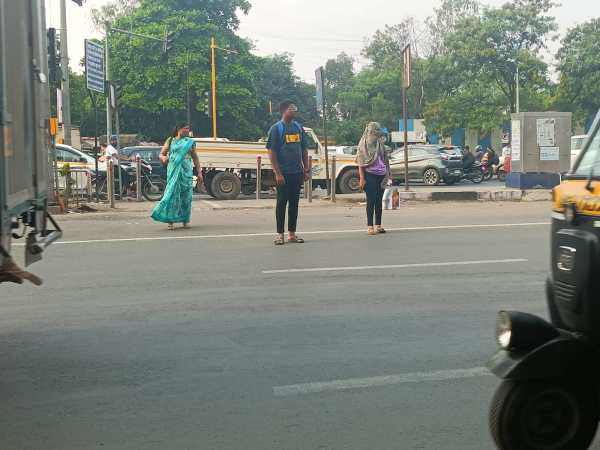Signal-Free Roads in Pune: Pedestrian Nightmare.

Posted by icarepune.com | May 12, 2025
Pune, a walk-friendly city it was, is turning into a nightmare for pedestrians. Pune Municipal Corporation (PMC) and Pune Traffic Police’s pursuit of signal-free roads, such as Nagar Road, gives precedence to speeding cars over pedestrian safety. At icarepune.com (ICP), we think every Punekar is entitled to safe, accessible roads—not highways that risk lives. This action disregards the city’s own Pedestrian Policy and exposes vulnerable populations—seniors, children, and the differently-abled—to danger. It’s time to refuse signal-free roads and call for pedestrian-centric city planning.
The Pedestrian Crisis in Pune
Pune’s roads are a war zone for pedestrians. In 2022, there were 105 reported pedestrian fatalities among 290 accidental fatalities in the city, with many occurring while crossing or walking on ill-maintained footpaths. Though the Indian Road Congress (IRC) rules require constant, safe pedestrian infrastructure and the PMC’s Pedestrian Policy (2016) guarantees universally accessible footpaths and crossings, the truth is dismal:
Just 53% of Pune roads have footpaths, and those that exist are encroached by vendors, cars, or building waste.
Zebra crossings, designed for safe crossing, are faded or missing at important junctions, as residents have complained since the 2024 monsoon.
Pedestrian signals are non-functional or are disregarded by drivers, and there are no arrangements for the visually impaired, even though such a commitment was made in PMC’s 2016 draft policy.
The introduction of signal-free roads exacerbates this crisis, turning crossings into high-speed gauntlets where pedestrians are left to fend for themselves.
Signal-Free Roads: A Recipe for Disaster
In March 2025, the Pune Traffic Police introduced a signal-free rotary system on Nagar Road, between Parnakuti Chowk and Wagholi, to decongest traffic. Right turns were prohibited, U-turns were facilitated, and traffic signals eliminated to facilitate “free movement” of vehicles. While drivers can speed past, pedestrians in areas such as Kalyaninagar, Vimannagar, Kharadi, and Chandannagar are taking the hit:
Long Walks to Crossings: Residents walk more than a kilometer to get to the nearest zebra crossing, as U-turns substitute for direct crossings. For instance, at Shastrinagar Chowk, the shutdown of the Kalyaninagar junction compels pedestrians to take a detour to a U-turn near Aga Khan Palace.
No Speed Control: Signal-free junctions do not have rumbler strips or speed breakers, and cars can speed through, putting pedestrians at risk. Kharadi resident Vishal Nair said, “Pedestrians’ safety has been neglected. Zebra crossing stripes have been removed.”
Impact on Vulnerable Groups: Senior citizens, like those near Ramwadi’s schools and hospitals, struggle to cross high-speed roads. Uddhav Galande, a Ramwadi resident, said, “There is a school and a hospital in Ramwadi. The traffic police need to ensure zebra crossings and pedestrian signals are in place.”
Higher Accident Danger: Without signals, pedestrians are left with lengthy waits or the danger of crossing in the middle of fast-moving traffic, raising the chances of accidents, particularly at night when the visibility is poor.
Deputy Police Commissioner (Traffic) Amol Zende asserts that the department is working with PMC to provide rumbler strips and zebra crossings, with 20–30 seconds of vehicle halts at major intersections. But these are insufficient and poorly enforced, exposing pedestrians.
Violating Promises and Rules
The signal-free initiative goes against PMC’s own policies and national guidelines:
PMC’s Pedestrian Policy (2016): Hears “well-designed, adequate in size, and universally accessible” footpaths and crossings, but signal-free roads take away crucial pedestrian signals and crossings.
IRC Guidelines: Highlight minimizing pedestrian-vehicle conflicts and providing safety to all, including the disabled. Signal-free roads go against these by giving vehicular flow priority.
Walk Smart Policy: Emphasizes the importance of sufficient pedestrian crossing time and good signals, but existing signal-free intersections mismatch signals with pedestrian routes, making them useless.
Civic activist Qaneez Sukhrani, who brought a Public Interest Litigation (PIL) in 2024, properly put it, “Pedestrians’ rights are neglected by the PMC. Basic facilities like at-grade pedestrian crossings and ramps for seniors and disabled persons are noticeably lacking.” The signal-free move is backtracking from those promises.
The Community’s Voice
Punekars are tired of waiting. Residents and activists have sounded off:
Manasi Kulkarni, Kothrud: “We struggle to cross roads, particularly in peak hours. These signals will work provided they are used effectively. Drivers of vehicles who disrepect these signals should be held accountable.”
Prashant Inamdar, Pedestrians First: “Pune is now the most pedestrian-unfriendly city. Even though Pune has been hailed for having a pedestrian policy, the ground reality is very different.”
Harshad Abhyankar, Save Pune Traffic Movement: “A foolproof and well-maintained system of signals, including pedestrian signals, should be available across areas. Citizens will get used to this system if it is available without any hindrances.”
These voices resonate with ICP’s mission: Pune’s streets must serve people, not only automobiles.
A Call to Action
At icarepune.com, we envision Pune as a city where walking is safe, accessible, and pleasant. Signal-free roads are not the solution—they put lives at risk and compromise sustainable urban mobility. We appeal to the PMC and Pune Traffic Police to:
Stop Signal-Free Initiatives: Restore pedestrian signals at all major intersections, making them visible, operational, and with audible buzzers for the visually challenged.
Repaint Zebra Crossings: Get high-priority repainting of dim crossings done as promised after Diwali 2023, and impose driver compliance using CCTV surveillance.
Deploy Speed Controls: Put up rumbler strips and speed breakers on signal-free junctions to slow traffic and save pedestrians.
Make People Count: Have residents, activists, and organizations such as ICP be a part of city planning so pedestrian interests are accounted for.
Stand with ICP’s Battle for Safe Streets:
Share This Post: Share this post on social media using #PuneWalksSafe to spread our message.
Pune’s streets belong to its people—walkers, cyclists, and drivers alike. Let’s reclaim them from the chaos of signal-free roads and build a city where everyone can move safely. Together, we can make Pune a pedestrian paradise again.
icarepune.com | Because Pune Cares
